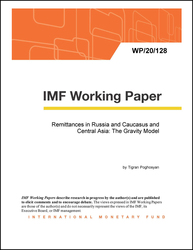
Remittances in Russia and Caucasus and Central Asia: the Gravity Model
Remittances in Russia and Caucasus and Central Asia: the Gravity Model
READ MORE...
Volume/Issue:
Volume 2020
Issue 128
Publication date: July 2020
ISBN: 9781513550206
$18.00
Add to Cart by clicking price of the language and format you'd like to purchase
Available Languages and Formats
| English |
Prices in red indicate formats that are not yet available but are forthcoming.
Topics covered in this book
This title contains information about the following subjects.
Click on a subject if you would like to see other titles with the same subjects.
Exports and Imports , Economics- Macroeconomics , Emigration and Immigration , WP , remittance , country , remittance flow , international remittances , migration , gravity model , recipient country , country j , bilateral remittance , pair level , sending country , Remittances , Gravity models , Oil prices , Exchange rates , Outward remittances , Central Asia and the Caucasus , Global
Summary
Remitances are an important source of external financing in low- and middle-income countries. This paper uses the gravity model to analyze remittance flows in Russia and Caucasus and Central Asia (CCA) countries. Standard gravity determinants, such as GDP in sending and recieiving countries, bilateral distance, existence of common borders and common official language, fit remittance flows well. Remittances also react to inflation and exchange rate movements in recipient countries to sustain their purchasing power. In line with the altruism hypothesis, remittances flow to countries with higher age dependency ratio. Remittances are countercyclical and help stabilize outputs in recipient countries. However, global shocks resulting in sharp output losses of sending countries would lead to large volatility and decline of remittance inflows in recipient countries. The results of the analysis can be used to assess the impact of the COVID-19 shock on projected remittance flows into CCA.
Copyright © 2010 - 2025
Powered by:
AIDC



